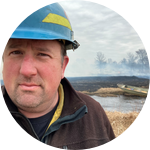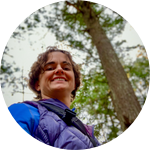About This Project
Moose are not recognized as a resident species in Wisconsin, likely due to insufficient data. Using trail cameras and field observations, I aim to test the hypothesis that Wisconsin hosts a self-sustaining moose population, with recurring adults, breeding, and calf recruitment. Findings shared with the Wisconsin DNR, the National Heritage Inventory, and other agencies will support efforts for formal recognition and conservation, highlighting the species' ecological role and habitat needs.
Ask the Scientists
Join The DiscussionWhat is the context of this research?
Inspired by my first encounter with a moose in Wisconsin, I became intrigued by how these large animals can live among us and yet remain mostly hidden. Discovering they are not officially recognized as resident species and thus lack conservation efforts, I began gathering data to support their formal recognition. Research, including Proximity to Established Populations Explains Moose (Alces alces) Occurrence in Northern Wisconsin (Olson et al., 2021), suggests moose sightings in Wisconsin are influenced by proximity to established populations in neighboring states. My project aims to fill the data gap and provide evidence that moose are an established resident species in Wisconsin, advocating for their formal recognition and conservation.
What is the significance of this project?
This project addresses a critical data gap in understanding the moose population in Wisconsin, which is currently unrecognized as a resident species. Without official recognition, moose lack state funding for monitoring and conservation. The decline of moose in Minnesota underscores the urgency of understanding moose populations in neighboring regions. Wisconsin’s population could provide valuable insights into the species' adaptability and conservation needs. By detailing population dynamics, breeding, and habitat use, this research aims to support official recognition, drive state-led conservation efforts, and enhance our understanding of moose at the southern edge of their range. This data is crucial for developing effective strategies to protect this sensitive species and its habitat.
What are the goals of the project?
The project aims to determine if Northern Wisconsin supports a self-sustaining moose population. Now in its 8th year, the study has identified key moose habitats but requires new equipment to replace failing devices and expand coverage to adjacent, unstudied areas. Using a Stratified-Random Design, trail cameras will be deployed in targeted locations to gather detailed data on moose behavior, movement, and habitat use. This will be complemented by field observations, providing critical insights into moose residency and supporting efforts for official recognition and conservation.
Budget
Trail cameras are essential for my research, providing non-intrusive, continuous observation of moose behavior and movements. They collect critical data on moose populations and habitat use, vital for tracking long-term trends. After eight years of use, my cameras are failing, compromising data quality and continuity.
I need to replace these cameras, along with batteries and memory cards, which are crucial for long-term operation in the field. Additionally, I require bear boxes and cable locks to protect the cameras from wildlife, particularly bears, and theft. These measures ensure that equipment remains secure and functional, safeguarding the investment and enabling consistent data collection to support my research efforts.
Endorsed by
 Project Timeline
Project Timeline
The project will continue until data confirms or refutes moose as an established resident species in Wisconsin. Within 30 days of receiving funds, new cameras, bear boxes and cable locks will be purchased, deployed, and calibrated to enhance data collection. This data will assess moose establishment based on population consistency, reproduction, and sustainability. Findings will guide official recognition efforts or clarify the current status.
Oct 04, 2024
Project Launched
Dec 06, 2024
New Camera Equipment Acquired: Essential tools purchased to enhance data collection.
Dec 29, 2024
Deploy the new cameras across the study area using the stratified-random design method
Feb 01, 2025
Begin reviewing data to ensure cameras are functioning correctly, adjusting placement or settings as needed
Jun 29, 2025
Conduct a full evaluation of the data collected during the first six months
Meet the Team
Amanda Griggs
I have always been deeply passionate about the outdoors and am dedicated to preserving the natural world. For me, there is nothing more fulfilling than being out in the wilderness, surrounded by the beauty and complexity of nature. This love for the outdoors has driven me to focus on supporting sensitive species that often go unnoticed, such as the elusive moose in Wisconsin.
For the past eight years, I have independently researched and monitored the moose population in Northern Wisconsin. My goal is to gather crucial data to help recognize moose as an established species within the state, a vital step toward ensuring their conservation and protection. With a background in citizen science, I am committed to bridging the gap between research and action by contributing valuable insights to wildlife conservation efforts and engaging with local and state agencies, as well as the broader scientific community.
In addition to my work with moose in Wisconsin, I actively participate in the Wolf-Moose Project on Isle Royale, where I volunteer every summer. I am also a Founding Board Member for the Wolf-Moose Foundation, which is committed to advancing this project to a fully self-sustaining status. This project and my own research underscore my belief that every species plays a vital role in our ecosystems, and that through dedicated research and collaboration, we can help protect and preserve these natural treasures for future generations.
Additional Information
Use of Stratified-Random Design in Camera Deployment
In reviewing An empirical evaluation of camera trap study design: How many, how long and when? by Kays et al. (2020), it is evident that camera trap study design significantly impacts the quality and accuracy of wildlife data collection. The study emphasizes the importance of optimizing camera numbers, placement duration, and timing to maximize detection probability and achieve robust population and behavioral insights. Drawing from these insights, I will employ a stratified-random design to ensure that camera deployment aligns with moose movement patterns and habitat use in Northern Wisconsin.
To effectively monitor moose populations and prove their residency status in Northern Wisconsin, I will employ a stratified-random design for trail camera placement. This design ensures that the camera distribution accounts for the diverse habitats and behaviors associated with moose movements, while also providing comprehensive data across different landscape types.
Stratification Based on Habitat Type and Moose Behavior:
Strata Definition: The study area will be divided into distinct strata based on key habitat types known to support moose. These include wetlands, dense forests, open areas, and transitional zones.
Wetlands: Moose frequently use wetlands for foraging, especially in summer, and these areas provide a rich source of aquatic vegetation. While wetlands are high-use areas, the likelihood of false triggers from moving water and vegetation requires a more cautious deployment strategy. Instead of focusing heavily on open marshland, cameras in wetland zones will be placed along edges where moose are more likely to traverse and where vegetation is less likely to trigger the camera.
Dense Forests: Moose use these areas for cover during the winter months and seek shelter from harsh weather conditions. These areas offer more controlled conditions for camera deployment, as vegetation is less likely to cause false triggers, and moose use them regularly for shelter during the winter.
Open Areas/Meadows: Moose are often observed feeding in open areas, particularly during the early morning and late evening hours. Although open spaces can capture feeding behavior, the risks of false triggers from wind-blown grass and temperature changes suggest a reduced focus on this habitat.
Transitional Zones: These are areas between dense forest and open habitat, where moose may travel between feeding and resting areas. Transitional areas between dense forests and open spaces are important corridors for moose movement and offer good conditions for capturing a variety of behaviors without high false-trigger risks.
Random Sampling Within Strata:
Within each habitat stratum, camera locations will be randomly selected to avoid bias and ensure even representation across the moose’s known range. This random sampling allows for the collection of data across all habitat types, ensuring that no one habitat type is over- or under-represented in the study.
Proportional Camera Placement:
Cameras will be distributed proportionally across the strata based on the known or estimated importance of each habitat type to moose. For example:
30% of cameras in Wetlands:
Cameras will be deployed at the edges of wetlands where moose are more likely to be observed moving in and out of the water, reducing false triggers from fluctuating marshland conditions. Strategic placement will focus on wetland access points and browsing areas near water sources.
35% of cameras in Dense Forests:
As these areas are critical for moose during the winter months, more cameras will be deployed here to monitor their sheltering and movement behavior. Forest conditions also reduce the likelihood of false triggers from environmental factors.
15% of cameras in Open Areas:
While open areas provide valuable insight into feeding behavior, the frequency of false triggers from wind and temperature variations warrants a reduced camera presence. Cameras will be positioned near known feeding grounds but with additional sensitivity settings to minimize false activations.
20% of cameras in Transitional Zones:
Transitional zones between habitat types are key movement corridors for moose. These areas will receive a higher allocation than open spaces due to the lower likelihood of false triggers and the opportunity to observe moose traveling between feeding and sheltering areas.
Additional Considerations
Camera Sensitivity Settings: Cameras placed in wetlands and open areas will have their sensitivity fine-tuned to reduce the likelihood of false triggers. Adjusting the motion detection sensitivity and using cameras with better filtering for environmental factors will be crucial.
Height and Angle: To further reduce false triggers, cameras will be mounted at appropriate heights and angles, particularly in open areas and wetlands. This will help avoid picking up swaying grass or ripples in the water.
Adjustments Based on Moose Movements:
While the initial placement will follow a stratified-random design, periodic review and adjustments will be made based on preliminary data and observed movement patterns. If certain habitats show higher-than-expected activity, additional cameras may be moved or added within that stratum to capture more detailed data.
Comprehensive Data Collection:
This method ensures that all critical habitat types within the study area are monitored, providing comprehensive data on moose movements, habitat use, and residency patterns. By covering a range of habitat types, I can better assess year-round use of the area by moose and provide strong evidence for their classification as a resident species.
Project Backers
- 46Backers
- 100%Funded
- $3,930Total Donations
- $85.43Average Donation



